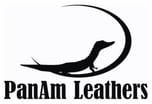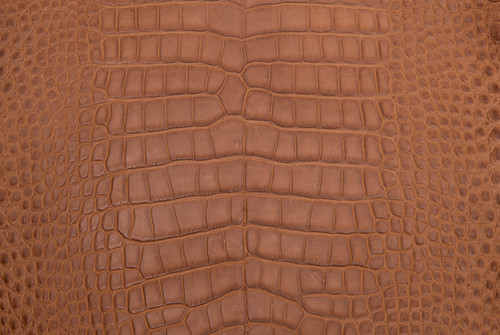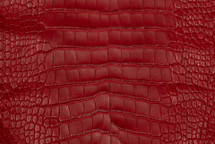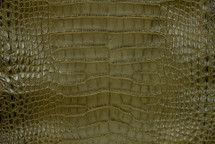- Home
- Skin Type
- Alligator Skin
- Alligator Skin Belly Matte Cognac 40/44 cm
Product Features
- Genuine American alligator skin
- Scientific name alligator mississippiensis
- These alligator skins are farmed for the meat. The skin is a byproduct.
- CITES Appendix II
- Native to southeast USA
- Tanned, colored and finished in USA
- Size is measured in centimeter width between the outer edges of the skin at the widest point in the belly
- The approximate average size and thickness of these alligator skins are:
- 168 cm full length
- 1.3 mm thickness
- Head: 30 cm long x 30 cm wide at the center (widest point)
- Belly: 36 cm long x 42 cm wide at the center (widest point)
- Tail: 85 cm long x 29 cm wide at the top of the tail (widest point)
- Grading recommendations as follows:
- Grade 3 or Better: ideal for footwear, wallets and garments
- Grade 5 or Better: ideal for belts, electronics accessories and other small leather goods
Alligator Skin
Alligator skin is commonly used for handbags, footwear, watchbands, garments, belts, wallets and other small leather goods and accessories. The American alligator (alligator mississippiensis) is native to the Southeast US. These animals are both wild-caught and farmed, both systems being monitored by each State’s Fish and Wildlife authority. In both cases, the skins are a byproduct of the meat. The wild season typically runs August through November, varying a little state by state. For the farming system, egg collection typically occurs in the month of June. The eggs are collected, brought to the farms to incubate, hatch and be raised. In some states, a certain percentage of those animals are returned to the wild at a certain age. The number of animals returned to the wild is guided by wild population levels, as monitored by Fish and Wildlife. The farmed skins typically run smaller than the wild skins as the animals get expensive to house and feed as they get older and bigger.
Alligators have been harvested for some two hundred years. Alligators were first harvested in Louisiana in great numbers in the early 1800's. These alligators were harvested for their skins which were used to make boots, shoes and saddles, and for their oil used to grease steam engines and cotton mills. The demand decreased when the leather made from the skins was thought not to be durable. In the mid 1800's the demand for alligator skins increased again. These skins were used to make shoes and saddles for the Confederate troops during the Civil War.
In the late 1800's and early 1900's, commercial tanning processes began in New York, New Jersey and Europe. Because this process made the alligator skins soft, durable and more pliable, the demand for alligator leather increased dramatically. By the mid 1900's Louisiana’s alligator population had been significantly reduced. In 1962, the alligator hunting season was closed statewide due to low numbers. The reduction in numbers was a result of non-regulated harvests. Detrimental harvest practices included overharvesting (today harvest quotas are set annually for each property currently hunted), non-selection of sexes which often resulted in overharvesting females (males currently comprise approximately 70% of adult alligators harvested) and no closed season, allowing hunting to coincide with nesting, which resulted in the harvest of future populations by harvesting females before they could release hatchlings from the nest or even begin nesting (current seasons are conducted in September after nesting). In 1967, the alligator was put on the endangered species list. By 1971, when the Crocodile Specialist Group began, all 23 species of crocodilian were endangered or threatened.
In an effort to restore the animal and the industry, researchers at Rockefeller Refuge in Louisiana developed a revolutionary program of alligator farming/ranching that removes eggs from the wild, incubates and hatches them, and then, two years later, returns between 14% and 17% of those hatchlings to the wild. Upon return, they are between three and six feet in length, healthy, and capable of defending themselves in the marsh. As a result, the percentage of returns (i.e. 14%) is greater than the survival rate for eggs left in the marsh. In 1972 the alligator season was opened only in Cameron Parish and lasted 13 days. Other parishes were gradually added until the season became statewide in 1981. Louisiana’s wild and farm alligator harvests currently exceed 300,000 animals annually, while the population level (based on aerial nest surveys) remains stable.
Due to the success of this "conservation through utilization" program, the alligator was removed from the endangered species list in 1987. This program also set an example that inspired similar sweeping changes in the crocodile locales across the globe. So much so that by 1996, one-third of all crocodile species were sufficiently abundant to support well-regulated annual harvests and one-third of the species were no longer in danger of extinction but were not harvested. No other group of vertebrate animals has undergone such a dramatic improvement in its conservation status.
We’re proud to be one of the few independent alligator skin tanneries in the world. Our commitment to properly tanning alligator skins which have been sustainably and ethically sourced is why our customers continue shopping with us. We follow best practices for tanning alligator skins while honoring the history of commercial alligator skin tanning to deliver the best alligator leather worldwide.
Sources: IUCN-SSC Crocodile Specialist Group (CSG), Convention on International Trade in Endangered Species of Wild Fauna and Flora (CITES), Louisiana Department of Wildlife and Fisheries
Alligator Skin Characteristics
American alligator skin has medium to large belly scales, without the follicle markings of other types of crocodile skins. The lack of follicle markings and relatively low calcium content make for a smooth scale appearance. It has a larger flank section and narrower belly section than most other crocodile species. Tails are also wider than average for crocodile species of similar size.
PanAm Leathers grades alligator skin on the midsection only, including the belly and flank. The condition of the head and tail are not considered in the grading. The grades are defined as follows:
-
Grade 1: No defects in the belly
-
Grade 2: One cluster of defects on the outer edge of belly or flank
-
Grade 3: One cluster of defects in the center belly
-
Grade 4: Clusters of defects in two different quadrants of the midsection
-
Grade 5: Worse than grade 4
Defects are most often scars, scratches, shading or scaling deformities. In some rare cases, defects may include holes and grain issues. Anything with holes or grain issues would be downgraded to a grade 4 at best. Skins that are grade 3 or better will not have holes or grain issues in the midsection. Both grade and size impact alligator skin pricing.
Alligator skin sizes are measured in cm at the widest point of the belly, not including any hard bone. Below are the average dimensions of each section of the skin for each size category. All measurements are in cm, except for average thickness which is in mm.
| Size Range | 20/24 cm | 25/29 cm | 30/34 cm | 35/39 cm | 40/44 cm | 45/49 cm | 50/54 cm | 55/59 cm | 60/64 cm |
| Width of head | 15 | 20 | 25 | 25 | 27 | 32 | 29 | 29 | 31 |
| Length of head | 15 | 20 | 30 | 25 | 30 | 35 | 34 | 34 | 39 |
| Width of belly | 22 | 27 | 32 | 37 | 42 | 47 | 52 | 57 | 62 |
| Length of belly | 19 | 30 | 35 | 35 | 36 | 36 | 39 | 42 | 45 |
| Width of tail at top | 17 | 20 | 24 | 27 | 29 | 33 | 37 | 41 | 44 |
| Length of tail | 43 | 50 | 65 | 70 | 85 | 90 | 94 | 98 | 108 |
| Total length | 88 | 100 | 150 | 155 | 168 | 178 | 180 | 182 | 197 |
| Avg thickness (mm) | 0.8 | 0.8 | 1 | 1.3 | 1.3 | 1.4 | 1.5 | 1.6 | 1.8 |
Common Uses for Alligator Skin
Alligator skin comes in a range of sizes and qualities which makes it a very versatile material in terms of product application. Below is a chart summarizing how alligator skin is typically used across the various sizes and grades. However, each project and customer has different preferences and requirements, so the below is meant as merely a guide:
| CM Size Range | Grade 2 or Better | Grade 3 or Better | Grade 5 or Better |
| 20/24 | Watchbands | Watchbands | Small leather goods, jewelry |
| 25/29 | Watchbands | Watchbands | Small leather goods, jewelry |
| 30/34 | Small handbags, footwear | Footwear, wallets, electronics accessories | Trim, small leather goods |
| 35/39 | Medium handbags, garments | Footwear, electronics accessories | Small leather goods, trim |
| 40/44 | Medium handbags, garments | Medium handbags, footwear | belts, small leather goods, trim |
| 45/49 | Large handbags, garments | Garments, footwear, upholstery, belts | Footwear, belts, small leather goods, trim |
| 50/54 | Large handbags, garments, upholstery | Garments, footwear, upholstery, belts | Footwear, belts, small leather goods, trim |
| 55/59 | Large handbags, garments, upholstery | Garments, footwear, upholstery, belts | Belts, Upholstery |
| 60+ | Luggage, upholstery | Luggage, upholstery | Belts, Upholstery |
Sustainability and Ethics for the Alligator Skin Trade
The alligator scores a 7 out of 10 in the PanAm Leathers Sustainability and Ethics Rating System. In biodiversity and meat use, it scores perfectly. On ethics, it scores a 1 out of 2, because the scientifically-backed ethical standards for how these animals are treated are still being developed and implemented, but steady progress is being made. On conservation, it scores a 2 out of 4 because it is CITES Appendix II, meaning the species is not in danger but must be trade-controlled to prevent exploitation. It is commonly accepted among conservation biologists that the American alligator is abundant in the wild population (at least three million animals), but remains on Appendix II because of its similar appearance to other crocodilian species that are more at risk.
Export/Import Information
-
Common name: American alligator
-
Scientific name: alligator mississippiensis
-
Country of origin: USA
-
Source: Wild. Even farm-raised American alligator skins are considered wild for Fish and Wildlife purposes, since they are not bred in captivity. The eggs are collected from the wild.
-
CITES status: Appendix II, which requires CITES to import/export.
-
 Louisiana Alligator Sustainability
Louisiana Alligator Sustainability -
 Louisiana Alligator Traceability
Louisiana Alligator Traceability -
 Louisiana Alligator CITES Feature
Louisiana Alligator CITES Feature










